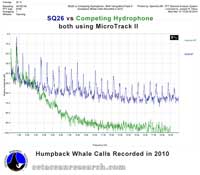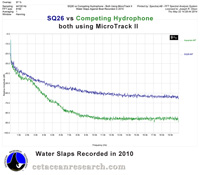Humpback to Humpback
SQ26-08 directly compared to competition
Want to hear the difference between our entry level hydrophone and the competition?
In 2010, one of our customers, Kim Cascone, recorded some humpback whales with both our Cetacean Research™ SQ26-MT (now the SQ26-H1) portable underwater recording system and a competing hydrophone model. Both were connected to the same MicroTrack recorder. This allowed a direct comparison of our SQ26-08 hydrophone to the competitor's hydrophone.
Additionally we made a base broadband recording, and then made a couple frequency spectra plots; one that compares the humpback calls and another that compares the base recordings. They are below for you to examine. The differences are interesting. Note, these recordings have been normalized to ensure the peak volume levels are the same.
humpback calls
This set, the first set is the most interesting.
The sound is from the same whale, but is not the exact same sound segment because the recordings were made sequentially.
Nevertheless, the first thing that will jump out at you is that the harmonic structure of the humpback's sound is nearly non-existent in the recording made with the competing hydrophone. This is because SQ26-08 has a much higher frequency response than the other hydrophone and is able to capture the subtle, yet very important, structure of the whale vocalizations.
base - wave slaps
The second set is also interesting, but is more technical in nature.
We have two clips of water slapping against boat to give us broadband sounds for comparing the general frequency response of the two hydrophones.
What you see in the plot of the water slaps spectrum is that the competing hydrophone starts to lose sensitivity at approximately 3kHz and has essentially no response above 10kHz. The SQ26-08 actually has a response to 40kHz, but the MicroTrack was set to record only up to 20kHz when these comparisons were made.
In general, due to the superior frequency response of our SQ26-08 hydrophone, the recordings from the competing hydrophone sound very muffled.
The frequency response of our SQ26-08 can be compared to that from a CD, while that of the other hydrophone is similar to what comes out of a telephone.
- SQ26-08 hydrophone with cable
The SQ26-08 hydrophone is a general purpose hydrophone ideal for whale watching, full audio-band signal detection, and mobile underwater recording; except it can NOT be used as a stand-alone hydrophone. It is a component in several Cetacean Research™ Hydrophone systems - more about the SQ26-08 hydrophone.
- sq26-h1
The versatile, portable SQ26-H1 hydrophone system is the most compact underwater recording system that exists. It includes a SQ26-08 hydrophone, Zoom H1 recorder, high fidelity mini speaker, more about the SQ26-H1 hydrophone system
- Plot Comparing Humpback Recordings
Calls from same whale, recorded in sequence.
Humpback Whale recorded by SQ26-08
Humpback Whale recorded by competitor
- Plot Comparing Base Recordings
Simultaneous recordings of wave slaps for baseline
Wave slaps recorded by SQ26-08
Wave slaps recorded by competitor




